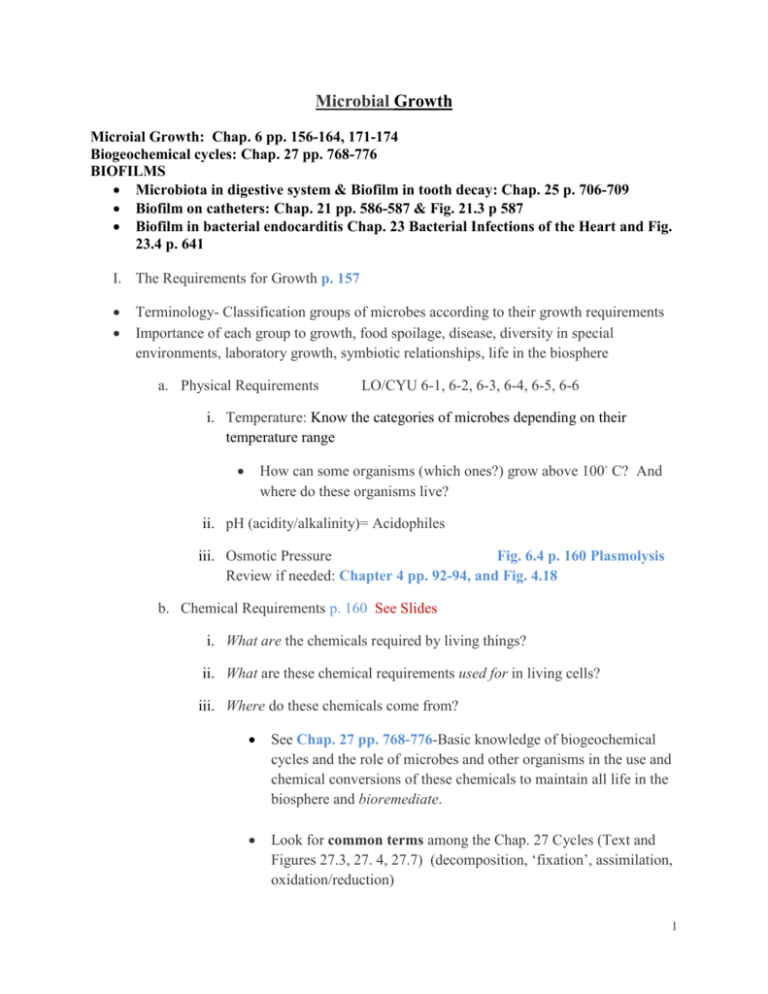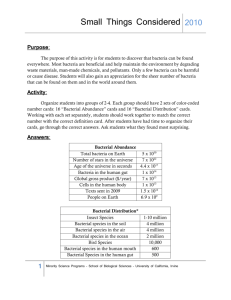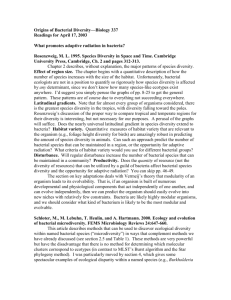Microbial Growth Microial Growth: Chap. 6 pp. 156-164, 171
advertisement

Microbial Growth Microial Growth: Chap. 6 pp. 156-164, 171-174 Biogeochemical cycles: Chap. 27 pp. 768-776 BIOFILMS Microbiota in digestive system & Biofilm in tooth decay: Chap. 25 p. 706-709 Biofilm on catheters: Chap. 21 pp. 586-587 & Fig. 21.3 p 587 Biofilm in bacterial endocarditis Chap. 23 Bacterial Infections of the Heart and Fig. 23.4 p. 641 I. The Requirements for Growth p. 157 Terminology- Classification groups of microbes according to their growth requirements Importance of each group to growth, food spoilage, disease, diversity in special environments, laboratory growth, symbiotic relationships, life in the biosphere a. Physical Requirements LO/CYU 6-1, 6-2, 6-3, 6-4, 6-5, 6-6 i. Temperature: Know the categories of microbes depending on their temperature range How can some organisms (which ones?) grow above ◦ C? And where do these organisms live? ii. pH (acidity/alkalinity)= Acidophiles iii. Osmotic Pressure Fig. 6.4 p. 160 Plasmolysis Review if needed: Chapter 4 pp. 92-94, and Fig. 4.18 b. Chemical Requirements p. 160 See Slides i. What are the chemicals required by living things? ii. What are these chemical requirements used for in living cells? iii. Where do these chemicals come from? See Chap. 27 pp. 768-776-Basic knowledge of biogeochemical cycles and the role of microbes and other organisms in the use and chemical conversions of these chemicals to maintain all life in the biosphere and bioremediate. Look for common terms among the Chap. 27 Cycles (Text and Figures 27.3, 27. 4, 27.7) (decomposition, ‘fixation’, assimilation, oxidation/reduction) 1 iv. Carbon cycle Also pp. 768-770 Fig. 27.3 Carbon Fixation and Respiration (Redox) Associations Global Warming? The structural ‘backbone’ of organic molecules ~Half the dry weight of a typical bacterial cell is C Carbon Sources: a. Chemoheterotrophs: use organic carbon sources (The specific organic carbon source(s) that can be used are determined by an organism’s DNA) b. Chemo- and Photo- Autotrophs: use CO2 v. Nitrogen cycle: pp. 770-772, Fig. 27.4 p. 770 Ammonification Nitrification Denitrification Nitrogen Fixation 2 Nitrogen continued… Needed for amino acids (proteins), nitrogen bases (DNA, RNA, ATP) ~ 14% of dry weight of a bacterial cell is N Most bacteria decompose proteins in the environment from other organisms, and rearrange these amino acids to form the proteins and other N-containing molecules they need Some bacteria use NH4+ (ammonium) or NO3–(nitrate) Many photosynthetic bacteria use N2 in the atmosphere during nitrogen fixation. N2 is 80% of Earth’s atmosphere. vi. Sulfur cycle Fig. 27.7 p. 774 In some amino acids, vitamins (thiamine and biotin). Some bacteria use SO42– or H2S for energy/e- donor/acceptor. v. Phosphorus pp. 774 In DNA, RNA, ATP, and membranes. PO43– is a source of phosphorus, changes little. Source: Rocks, sea sediment, soil, solubilized by the acid produced by bacteria, not returned to the atmosphere like CO2, N2, SO2 vi. Other elements and inorganic trace elements p. 774 K, Mg, Ca, inorganic trace elements (Fe, Zn, Cu, etc.- often used as enzyme cofactors)- Found in tap water 3 vii. Oxygen p. 161 Table 6.1 p. 161 Effects of Oxygen on the Growth of various Types of Bacteria Categories of microbes depending on their oxygen requirements/tolerance Toxic effects of oxygen and how organisms do or don’t cope with these toxic affects If an organism can’t obtain oxygen from atmospheric oxygen gas (O2), where does it get it from? If an organism doesn’t use oxygen as its final electron acceptor, what could it use? See Chap. 5 Outline An organism’s oxygen requirements will determine where in the above test tubes it can grow. iv. Organic Growth Factors 1. Organic compounds an organism is unable to synthesis, must be obtained directly from the environment 2. Types of organic growth factors: a. Vitamins: Many vitamins function as the organic cofactors (coenzymes). 4 b. For any individual species, any organic compound that cannot by synthesized from precursor metabolites is an organic growth factor for that species. c. Certain amino acids and nucleic acid nitrogen bases are considered to be organic growth factors for that some species. In humans, the essential amino acids are organic growth factors and must be obtained directly in our diet. See: http://hyperphysics.phy-astr.gsu.edu/hbase/organic/essam.html II. Bacterial Growth as Biofilms p. 162 LO/CYU 6-7 a. Definition: Three dimensional communities of microbes (one or more species) living in a ‘hydrogel’ consisting of organic molecules (mostly polysaccharides). These microbes signal each other and respond to those signals in a variety of ways depending on the species and where the biofilm is located. Staphylococcus aureus and Pseudomonas aeruginosa biofilms 5 b. Examples of biofilms in nature and the environment: How is it bad for us and how is it good for us/other organisms? See info concerning i. Digestion and Biofilms Ruminant animal stomachs Human digestive system-types of bacteria? Functions? (See Chap. 25, p. 706) ii. Human Disease and Biofilms What % of human bacterial infections involves biofilms, according to the CDC’s estimations? Catheters and other medical devices (Clinical Focus p. 164, pp. 586-587 & Fig. 21.3 p 587) Chap. 23 Microbial Diseases of the Cardiovascular System (See Bacterial Infections of the Heart and Fig. 23.4 p. 641) Bacterial diseases of the Mouth-basically caused by biofilms (Chap. 25, pp. 707-709) Applications of Microbiology What is that Slime p. 57 c. Prevention and Treatment III. Culture Media (Lab, Not on lecture exam) IV. Obtaining Pure Cultures (Lab, Not on lecture exam) V. Preserving Bacterial Cultures (Not on lecture exam) 6 VI. The Growth of Bacterial Cultures p. 171 LO/CYU 6-14, 6-15 R 1, 2, 6 MC 8, 1-0 a. Bacterial Cell Division- Binary Fission p. 171 Usually, when we speak of bacterial growth, it is the number of cells, not the size of the cells themselves. b. Generation Time p. 171 i. Be able to calculate doubling time: X x (2 y) ii. 2 because it is doubling, X = starting number of cells, and Y= the number of generations 7 c. Logarithmic Representation of Bacterial Populations p. 171-173 Logarithmic scales are used to illustrate very large (or very small) numbers. Because the numbers of microbes reach millions, billions, trillions, very quickly, to illustrate the population changes in microbes, this exponential growth is expressed as the log of the population numbers. Using Log10 Log of 1,000,000 (= 106) is expressed as 6 d. Phases of Growth p. 172-174, Fig. 6.15 p. 173 KNOW THE BACTERIAL GROWTH CURVE PHASES and why. e. Direct Measurement of Microbial Growth (Not on lecture exam) f. Estimating Bacterial Numbers by Indirect Methods (Not on lecture exam) 8






